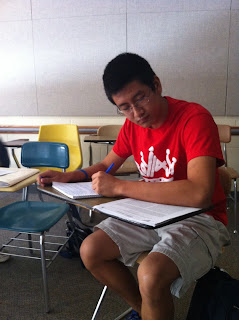SRAPer: Maddie Zoltek
Home state: Illinois
Grade in school: High School Senior
Plans after High School: Attend college to study biochemistry or biomedical engineering
Home state: Illinois
Grade in school: High School Senior
Plans after High School: Attend college to study biochemistry or biomedical engineering
Maddie Zoltek hasn't always loved science. Her sophomore
year of high school, however, changed that.
“I hated science up until then; I didn't think it was
interesting,” Maddie says. “But when I took chemistry my sophomore year, I
really liked it because of the awesome teacher I had. So, I started doing more
research and getting more involved in it.”
“I thought chemistry was really interesting,” Maddie says. “Whenever
we did labs in class, I loved doing them. I like the math involved too; it was
just something that I really understood and I feel like I can apply it in a lot
of ways. I just thought it was such a cool class.”
Maddie’s SRAP project involves working with Dr. Dongmei (Katie) Li, a professor in the Department of Chemical and Petroleum Engineering.
Maddie will take the knowledge she gained in chemistry and apply it to improve
the durability of fuel cells.
“I have been working with fuel cells,” Maddie says. “When we make a fuel cell using the
alternative approach, we dip the membrane in a chemical solution serving as a
‘glue’ instead of using heat and mechanical pressing. My project involves
testing the effect of different times on the durability and overall performance
of fuel cells.”
A fuel cell creates an electric current from a chemical
reaction and is used in areas such as transportation, stationary power, and
more.
“The kind of fuel cell we work with generates electricity
from hydrogen and oxygen,” says Dr. Li. “And then you can generate electricity
in which you can stack all of these single cells up to power your car.”
Maddie says that one of her favorite parts about creating
and testing fuel cells is being able to work in the lab and get her hands
dirty.
The research that Maddie is working on and the techniques
she’s learning will be beneficial for her future.
“The molecule she’s using is mostly used in biochemistry,” says
Dr. Li. “Researchers use that compound for various reasons in the field of
biochemistry.”
Maddie is greatly enjoying her research project this summer,
and she’s excited about the opportunity to be working in the field she loves
while gaining invaluable knowledge and experience.
SRAP is a six-week intensive research program for high school students. It is based at the University of Wyoming and sponsored by Wyoming EPSCoR.
By Robin E. Rasmussen and Kali S. McCrackin
Photos by Robin E. Rasmussen


